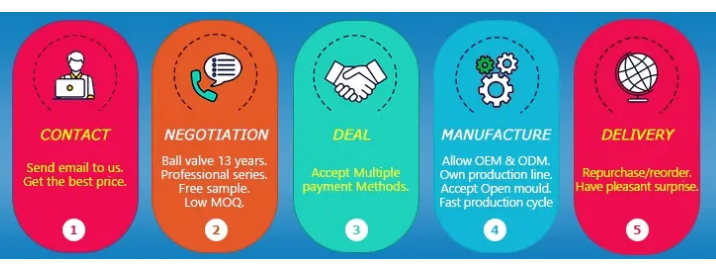Having a long service life and maintenance-free period will depend on the following factors: normal operating conditions, maintaining a harmonious temperature/pressure ratio, and reasonable corrosion data.
When the ball valve is closed, there is still pressure fluid in the valve body.
Before maintenance: release the pipeline pressure, keep the valve in the open position, disconnect the power or air source, and separate the actuator from the bracket.
Before the disassembly and decomposition operation, the pressure of the upstream and downstream pipelines of the ball valve must be checked.
During disassembly and reassembly, care must be taken to prevent damage to the sealing surfaces of parts, especially non-metallic parts. Special tools should be used when removing O-rings.
The bolts on the flange must be tightened symmetrically, gradually, and evenly.
The cleaning agent should be compatible with the ball valve's rubber, plastic, metal, and working medium (such as gas). When the working medium is gas, the metal parts can be cleaned with gasoline (GB484-89). Clean nonmetal parts with pure water or alcohol.
Non-metallic parts should be removed from the cleaning agent immediately, and should not be soaked for a long time.
After cleaning, it is necessary to volatilize the wall cleaning agent (wipe with a silk cloth that has not been soaked in the cleaning agent) to assemble, but it should not be put on hold for a long time, otherwise, it will rust and be polluted by dust.
New parts should also be cleaned before assembly.
During the assembly process, there must be no metal debris, fibers, oil (except for specified use), dust and other impurities, foreign matter, and other contamination, adhering to or staying on the surface of the parts or entering the inner cavity. Lock the stem and nut if there is a slight leak in the packing.
A), dismantling
Note: Do not lock too tightly, usually 1/4 to 1 more turn, the leakage will stop.
Put the valve in the half-open position, flush, and remove the dangerous substances that may exist inside and outside the valve body.
Close the ball valve, remove the connecting bolts and nuts on the flanges on both sides, and then completely remove the valve from the pipe.
Disassemble the drive device in turn - actuator, connecting bracket, lock washer, stem nut, butterfly shrapnel, glam, wear-resistant sheet, stem packing.
Remove the body cover connecting bolts and nuts, separate the valve cover from the valve body, and remove the valve cover gasket.
Make sure the ball is in the closed position, which makes it easier to remove from the body, then remove the seat.
Push the valve stem down from the hole in the valve body until it is completely removed, and then take out the O-ring and the packing under the valve stem.
B), reassemble.
Note: Please operate carefully so as not to scratch the surface of the valve stem and the sealing part of the valve body stuffing box.
Cleaning and inspection of disassembled parts, it is strongly recommended to replace seals such as valve seats, bonnet gaskets, etc. with spare parts kits.
Assemble in reverse order of disassembly.
Cross-tighten the flange connection bolts with the specified torque.
Tighten the stem nut with the specified torque.
After installing the actuator, input the corresponding signal, and drive the valve core to rotate by rotating the valve stem, so that the valve reaches the switch position.
If possible, please carry out a pressure sealing test and performance test on the valve according to relevant standards before reinstalling the pipeline.
Post time: Jun-14-2022








